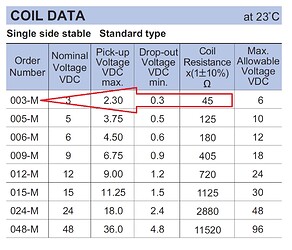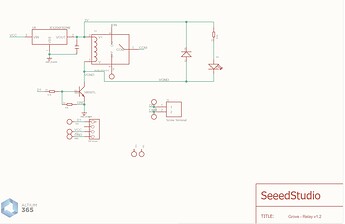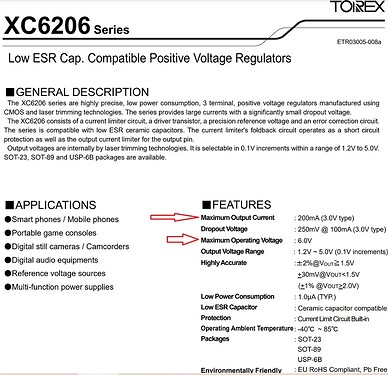I have a 3.3v based Arduino (power and logic level), and from what I see the Grove - 2 coil latching relay is 5v but then it shows an example of using it with a Raspberry Pi (which is 3.3v). Does anyone know if it works with 3.3v Arduino’s/Raspberry Pi’s? Thanks
Link is below
Hi there,  So check this OUT!
So check this OUT!
I wondered that exact question , as I’m doing a Solenoid which is similar.
I clicked on your LINK and viewed the Data-Sheet link contained on there. It HAS it ALL … WOW 
YES the answer is indeed there in the coil section and the secret on page 43, Note:2
I’ll let you  take that same walk through the Documentation… and throw you a bone in being mindful of NOTICE 5 on page 45.
take that same walk through the Documentation… and throw you a bone in being mindful of NOTICE 5 on page 45.
I wish it weren’t so Huge though, the Physical size limits it’s practical use in small battery operated devices. WE need micro size. with say 3.3vdc w/2.34 volt latching.
HTH
GL
:-p
You give me too much credit I am not a smart man. I’ve spent over 8 hours trying to figure this out on my own, was even up to 2am last night. But, after your comment I’m still pretty much where I was.
This is what I left off with last night. Reading the datasheet (and seeing the picture) it looks like the relay is the 005-S-L2. It says the set/reset voltage is 4V. That means it can’t work with 3.3V Arduino’s.
But here Grove - 2-Coil Latching Relay - Seeed Wiki is their example of using it with a 3.3V Raspberry Pi… but it shouldn’t be able to (from what I understood from the datasheet). That makes me think there’s a voltage booster on the card so it can work at 3.3V but I wouldn’t be able to tell if it was right there in the schematics.
So I’m still where I was… looking at the data sheet seeing it needs at least 4V if looking at only the relay but also seeing they have a 3.3V Raspberry Pi example so I think the card has a voltage booster but I wouldn’t be able to tell.
Well, maybe I did finally come to a possible answer.
The Raspberry Pi example uses the GrovePi or GrovePi+. Looking at the GrovePi+ according to this document GrovePi Plus - Seeed Wiki it boosts the voltage from 3.3v to 5v. So, because the GrovePi+ changes the voltage from 3.3V to 5V on the ports it can work. However, the Arduino Grove Shield does not boost the voltage, if your Arduino is 3.3V you have to set the switch on the grove shield so it too will use 3.3V. Because of that, that’s the reason it will work with the mentioned Arduino’s (which are 5V) and a Raspberry Pi using the GrovePi+ shield (which boosts voltage from 3.3V to 5V).
Now I’m leaning more to it will not work with a 3.3V Arduino.
LOL, Ok well good effort.
So it’s all about the relay, here is the schematic https://oshwlab.com/seeedstudio/Grove_2_Coil_Latching_Relay-nlDVP6oGA
in the coil section of the data sheet link
see the notes. I’m of the opinion that as long as you can supply enough current to drive it, then it should work with a 3.3v (notes
#2).
HTH
GL

Thanks. I was thinking if they used the 003 but from what I see they used the 005 relay (picture shows 005-S-L2) is the relay they chose to put on the board. Which is a bummer. I was wondering what if I un-soldered the 005-S-L2 and put a 003-S-L2 on there…  but I can barely solder 2 wires together. I did learn a lot thank you.
but I can barely solder 2 wires together. I did learn a lot thank you.
well I looked at that grovepi-plus link, I see this on the relay
the schematic 3.3v components,
the LDO on there is also 3.3v. but WILL operate up to 6vdc. So 3-5v range is true.
XC6206P302MR,
that to is an option. IMO.
HTH
GL

Thank you. That is really hopeful news. I’m going to purchase a few, they’re not that expensive and post back (may be a few weeks) but your info looks more updated/reliable and I really, really need them.
I can confirm they are 5V only. I also contacted Tech Support (kudo’s for them getting back to me) that confirmed not only that they are 5V, but the reason they can work with Pi’s is because their Pi shield boosts the voltage to 5v. The relays I got are HFD2/005-S-LS-D… had they only been the /003 instead of /005. sigh I did post a comment on the product page about it.
The good news (so far) is that it has been working at 3.3v for me (measured 3.28v with a multimeter). I’ve done over a hundred flips tested with a multi-meter and it has not failed to flip at 3.3v yet. But, that’s probably not a guarantee. Who knows with wear. But, I do have a current sensor attached I can test if I shut it off and detect no change in current try again… after x many times have it notify me.



